Indications
Relative contraindications
Absolute contraindications
Reactive arthritis
Gravidity and breastfeeding
Haemarthrosis
Arthritic Lyme disease
Chronic pyrophosphate arthropathy [4]
Seronegative spondyloarthropathy psoriatic arthropathy [19]
Local skin infection at the injection site
Conditions that increase the risk of radionecrosis in case of unintentional leakage, for example, Baker’s cyst [15]
Haemophilic arthropathy for prophylaxis of chronic bleeding [18]
Recently ruptured synovial cyst communicating with the articular cavity
Pigmented villonodular synovitis (PVNS)
Periprosthetic joint infection
Undifferentiated chronic arthritis [21]
Synovitis in painful arthroplasty [21]
In young patients (<20 years) RSO should be performed with all due caution. The main indications in infants and adolescents are haemophiliac joint disease and pigmented villonodular synovitis. The time interval between arthroscopy or open knee surgery and RSO should be at least 4–6 weeks to minimize any risk of protracted wound healing.
A good indication for RSO is persistent knee pain, effusion and swelling. In young patients (<20 years) RSO should be performed with all due caution. The time interval between arthroscopy or open knee surgery and RSO should be at least 4–6 weeks to minimize any risk of protracted wound healing.
Pre-RSO Diagnostics
As RSO is a second- or even third-line treatment. All patients need undergo extensive diagnostic workup before RSO to exclude other causes such as mechanical loosening, instability, TKR malposition or infection.
Radiopharmaceuticals
Based on its physiochemical properties, 90-yttrium (Y-90) is the radionuclide of choice for RSO of the knee joint (Fig. 38.1). Y-90 is available as Y-90 citrate and Y-90 silicate. Both radiopharmaceuticals show different stability and drainage from the joint. Due to longer deposition in the knee, some authors like Gumpel et al. recommended Y-90 silicate [6]. Y-90 is a pure ß-emitter. The therapeutic ß-radiation penetrates the synovial membrane by 3.6 mm in the mean and by 11 mm in the maximum. The half time is 64 h, and the maximum energy emitted is 2.27 MeV [20].
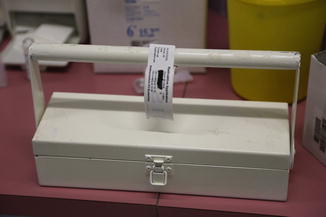

Fig. 38.1
Based on its physiochemical properties, 90-yttrium (Y-90) is the radionuclide of choice for RSO of the knee; Y-90 is available as Y-90 citrate and Y-90 silicate
90-Yttrium (Y-90) is the radionuclide of choice for RSO of the knee joint. It is available as Y-90 citrate and Y-90 silicate.
Therapeutic Procedure
The tracer is injected intra-articularly under aseptic conditions. Fluoroscopy is used to facilitate the correct needle position (Figs. 38.2, 38.3 and 38.4). In addition to the tracer, 10–20 mg of a glucocorticoid suspension like triamcinolone acetate is injected (Figs. 38.4 and 38.5). This glucocorticoid aims to reduce the radiation-induced synovitis and the risk of leakage by reduction of hyperperfusion and vascular permeability [10]. It also avoids tracer backflow into the needle. If there are any reasons not to apply steroids, it is necessary to flush the needle with saline solution to prevent backflow and to minimize the risk of radionecrosis.
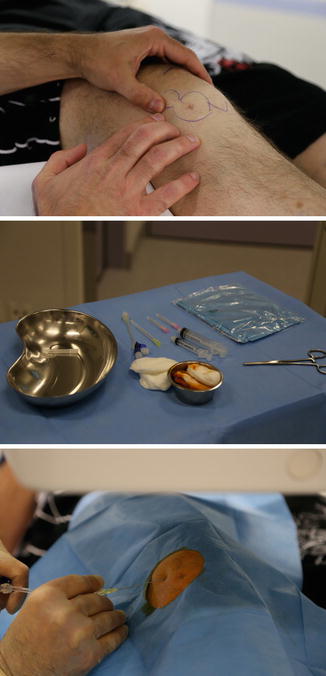
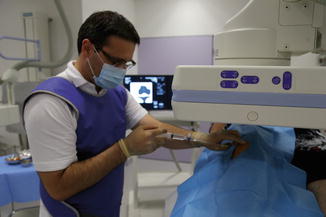
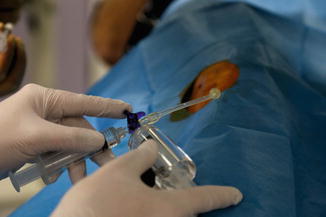
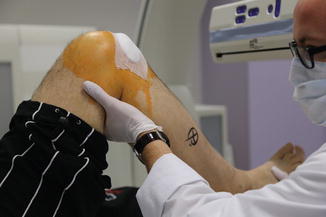

Fig. 38.2
The knee joint is palpated, and the necessary portals are marked. Then the knee joint is disinfected and sterile draped

Fig. 38.3
This image shows the interventional radiologist or nuclear medicine specialist performing the knee joint injection, which is fluoroscopy guided

Fig. 38.4
In addition to the tracer, 10–20 mg of a glucocorticoid suspension like triamcinolone acetate is injected. This glucocorticoid aims to reduce the radiation-induced synovitis and the risk of leakage

Fig. 38.5




After injection the knee is flexed and extended to achieve sufficient distribution of the radiopharmaceutical substance
Stay updated, free articles. Join our Telegram channel

Full access? Get Clinical Tree








